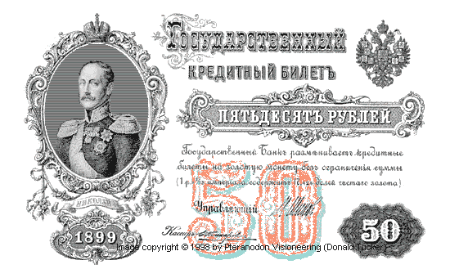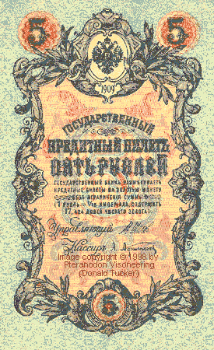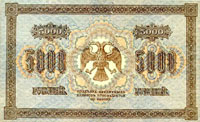(During the Russian Empire and after the Revolution of 1917)

Nicholas II Tzar of Russia, 1894-1917 AD
Silver 50 Kopeks, 27 mm. – Dated 1899 A.D. – St. Petersburg mint
 |
The 100 Ruble banknote of 1910
From the late 18th century until 1917 the Krim (Crimea) peninsula and the mainland portion of Taurida Oblast (province) was part of the Russian Empire, and used Russian currency. The Russian empress who conquered the territory — Catherine II (known as Catherine “the Great”) — was memorialized on Russian currency, along with notable Tsars such as Peter I (also honored with “the Great”).
 |
Imperial Russian designs for paper money were generally of high quality. This classical design, with a portrait of Tsar Nicolas, is for a 50 Ruble banknote issued in 1899.
Most commerce in Imperial Russian Crimea/Tauridia was conducted with smaller denomination currency. In the period just before the Great War this included coins valued in Rubles, Kopecks and fractional values of Kopecks:copper: 1/4, 1/2, 1, 2, 3, and 5 Kopecks / Silver: 5, 10, 15, 20, 25, and 50 Kopecks / Gold coins: 5, 10 Rubles. It also included paper money valued at 1, 3, 5, 10,25, 50, 100, and 500 Rubles.
 |  |
The 5 Ruble banknote of 1909
Imperial Russian designs for paper money were generally of high quality, including this beautifully designed 5 Ruble banknote of 1909
 |  |
The one Ruble banknote
Imperial Russian designs for paper money were generally of high quality. However, the one Ruble and Kopeck notes were issued with utilitarian designs of little artistic merit. On the one Ruble note the architectual motif is reduced to the facade of a nondescript generic structure.
 |  |  |
1917 -1918 1918 1917
 |  |  |
915 – 1917 stamp currency 1915 fractional notes 1905 – 1917
 |  |  |
1898 – 1899 1892 – 1896 1887 – 1892
 |  |  |
1843 – 1865 1840 – 1841 1818 – 1840
 |  |
